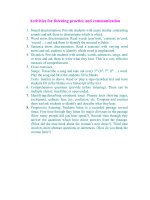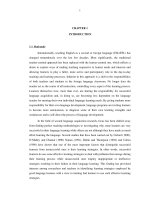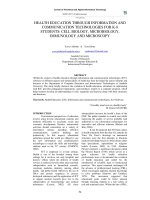Teamwork and communication
Bạn đang xem bản rút gọn của tài liệu. Xem và tải ngay bản đầy đủ của tài liệu tại đây (208.97 KB, 29 trang )
Teamwork and
Communication
Paula S. Kent, RN, MSN, MBA
Patient Safety Coordinator
The Johns Hopkins Hospital
Baltimore, Maryland
USA
ACKNOWLEDGEMENT
The slides and videos used in this presentation have been
customized from the Department of Defense TeamSTEPPS
program.
TeamSTEPPS[TM] is an evidence-based teamwork system to
optimize patient outcomes by improving communication and
teamwork skills among health care professionals. Slides and
videos are made available through the Agency for Healthcare
Research and Quality.* General permission has been given to
customize the slides to meet the needs of this program.
*TeamSTEPPS™: Strategies and Tools to Enhance Performance and Patient
Safety. Agency for Healthcare Research and Quality, Rockville, MD.
/>
Teamwork is the ability to work as a
group toward a common vision, even
if that vision becomes blurry.”
(Author Unknown)
“Communication is the response
you get from the message you
sent regardless of its intent.”
(Author Unknown)
Objectives
1. Describe the importance of teamwork and
communication in the hospital setting
2. Identify challenges to effective teamwork
and communication
3. Recognize the connection between
communication and patient safety
4. Define mutual support
Communication is…
• the process by which information is exchanged
between individuals, departments, or
organizations
• the lifeline of the front line staff e.g., charge nurse,
physician team leader and the direct care
providers on the unit
• most effective when it permeates every aspect of
an organization and unit
Why is Communication so Vital in
Hospital Settings?
• It affects the functioning of the team caring for
patients
• Numerous handoffs occur-between levels of care,
shifts and providers
• Many care providers are involved in the care process
e.g., nurses, doctors, consult services, therapies and
ancillary services
• Clinical diagnosis, therapies, procedures and the
patient’s outcomes depend on accurate information
• Communication is essential for effective patient care
in the 24X7 healthcare environment
Joint Commission: The
Importance of Communication
Voluntary reporting of sentinel events to the Joint
Commission reveals:
Ineffective communication is a
root cause for nearly 66 percent
of all sentinel events reported*
* (JC Root Causes and Percentages for Sentinel Events (All
Categories) January 1995−December 2005)
NUMBER 1
ROOTCAUSE
Challenges to Effective Teamwork
and Communication
• Healthcare environments challenge the
communication process in hospital settings.
• Each challenge creates an opportunity for a
potential medical error.
• Many factors can “fuel the fire” for ineffective
communication.
Factors that Challenge Effective
Teamwork and Communication …
• Language barriers and varying communication
styles
• Distractions
• Misinterpretation of non-verbal cues
• Personality characteristics
• Workload
• Conflict (unresolved or in progress)
• Lack of information verification
• Shift change/Handoffs
The Joint Commission has set Goals
Related to Improving Communication
National Patient Safety Goals related to
communication
– Improve the effectiveness of communication
among caregivers by using Read-Back and
Handoff
– Completely reconcile medications and other
treatments across the continuum of care
– Encourage the active involvement of patients and
their families in the patient’s care as a patient
safety strategy
Standards of Effective Communication
• Complete
– Communicate all relevant information, avoid unnecessary
details
– Leave time for questions and answer questions
• Clear
– Convey information that is plainly understood
• Brief
– Be concise
• Timely
– Avoid delays in relaying information/patient could be
compromised
Information Exchange Strategies
Information exchange strategies have the potential to
reduce medical errors related to miscommunication.
Four strategies include:
1. Situation–Background–Assessment–
Recommendation (SBAR)
2. Call-Out
3. Check-Back
4. Handoff
ANYONE on the team can use these strategies!
SBAR…
• provides a framework for team members to
effectively communicate about a patient’s
condition
• communicates the following information:
– Situation - What is going on with the patient?
– Background - What is the clinical background
or context of the situation?
– Assessment - What do I think the problem is?
– Recommendation - What would I recommend?
Call-Out…
A Call-Out is a strategy used to communicate
important or critical information during an
emergent event.
Call-outs
– inform all team members simultaneously
during
emergency situations
– help team members anticipate next steps in
patient care
– benefits a scribe taking patient notes during
event
Check-Back
• A Check-Back is a strategy to “close the
communication loop”
• The Check-Back process occurs when:
• the sender initiates a message
• the receiver accepts message and confirms what
was heard
• the sender verifies message received
• If a call-out strategy requires a response in the form of
an order; the order is then verified with a “check-back”
• A check-back is similar to a “read-back” for verbal
orders
Handoff
A Handoff is designed to enhance the exchange of
information at critical times in the patient’s care
A handoff includes:
– transferring information (along with authority
and responsibility) during transitions in care
across the continuum (e.g., between shifts, ICU
to inpatient transfer, OR to PACU)
– providing an opportunity to ask and respond to
questions
– maintaining continuity in care even though the
care giver changes
What is Mutual Support?
– Mutual support is the essence of teamwork,
simply stated it is “backing up your fellow
team members”
– Mutual support protects team members
from work overload situations that may
reduce effectiveness and increase the risk
of error
When is Mutual Support Needed?
Any time a unit is in the “work overload”
mode. This can occur with
–any unexpected event on a unit
–new patients being simultaneously
admitted to the unit
–other departments being backed-up
and delayed
–abrupt changes in a patient’s status
Mutual Support:
What does it look like?
Back-up Behavior
• Monitoring team members performance to
anticipate if assistance is needed-constant
situational awareness.
• Cautioning team members if there is a potential for
an unsafe situation.
• Distributing and assigning work thoughtfully.
• Reassigning work if a team member gets
overwhelmed-giving a team member time to
regroup.
• Providing constructive feedback to others to
improve performance.
Mutual Support: Task
Assistance
In a Culture of Safety it is expected that
assistance will be actively sought and offered as
a method for reducing the occurrence of error.
Mutual Support: Feedback
• Feedback is the giving, seeking, and receiving
of performance-related information.
• Feedback can be formal or informal.
• Anyone on the team can give feedback.
What to do when there are
Differing Points of View
• Advocate for the patient or staff member even
if your opinion is not popular
• Assert your opinion in a firm and respectful
manner
• Always provide your evidence for your
concerns
Failure to speak up can lead to adverse
events!
Challenges to Providing
Mutual Support
“I’d like to provide mutual support but…..”
• “I don’t have enough time to get my own work
done”
• Be adaptable: Ask someone else to provide
assistance to your colleague.
“I’d like to provide mutual support but…..”
• “My colleague is going to feel I am criticizing
him/her”.
• State your intention-you are trying to lessen
their workload or improve on their
performance









